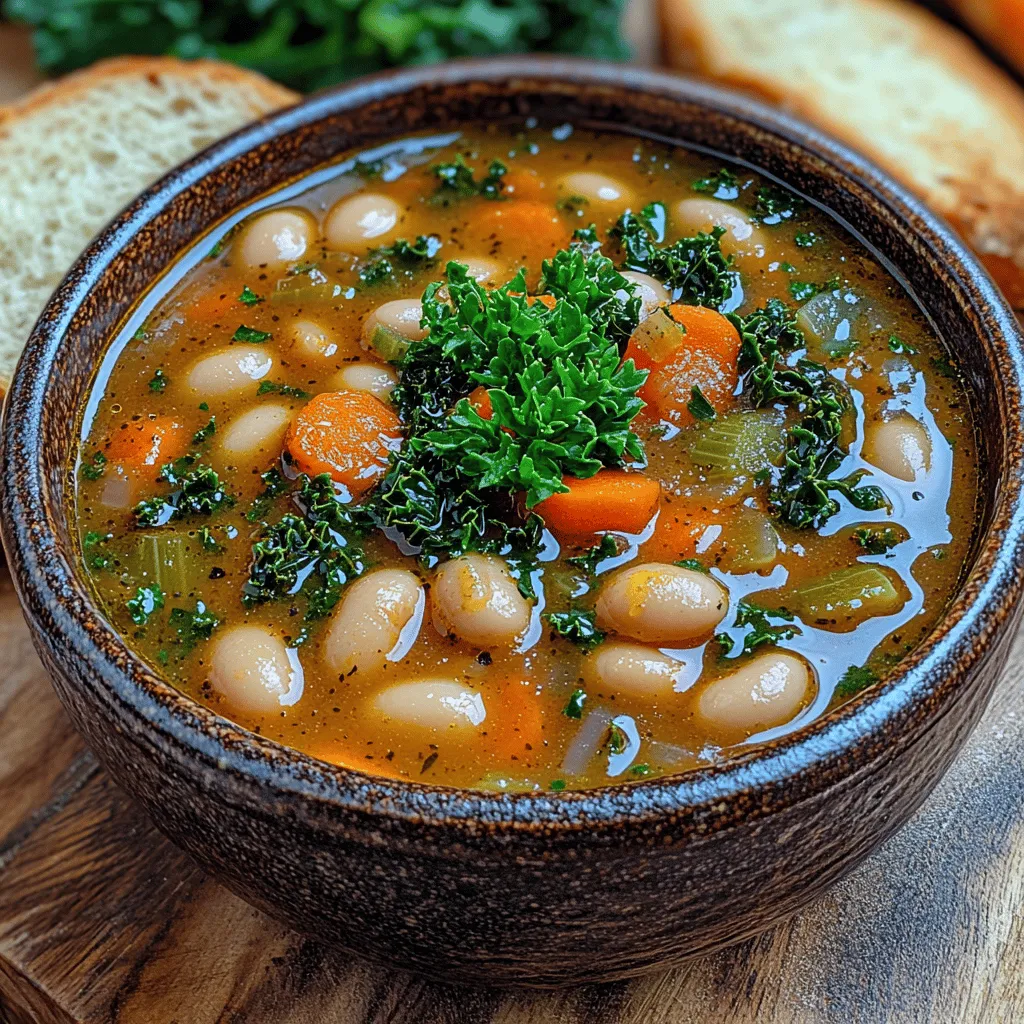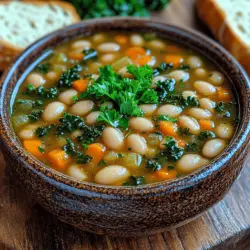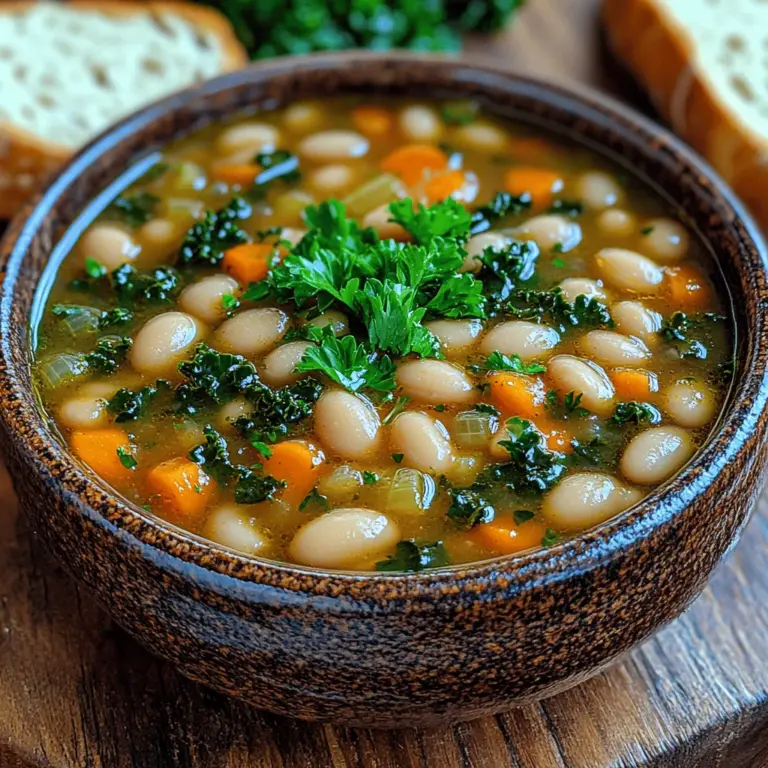Introduction
Hearty Tuscan White Bean Soup is more than just a dish; it’s a culinary embrace that warms the soul. Originating from the lush landscapes of Tuscany, this soup is a tribute to rustic Italian cooking, featuring simple yet flavorful ingredients that showcase the region’s agricultural bounty. Traditionally, Tuscan cuisine emphasizes the use of local produce, legumes, and herbs, resulting in dishes that are both satisfying and nourishing.
The appeal of Hearty Tuscan White Bean Soup lies in its rich, creamy texture and delightful flavors, making it an ideal meal for chilly evenings or a comforting lunch. It harmoniously combines the earthiness of white beans with the freshness of vegetables and herbs, creating a dish that is not only delicious but also packed with nutritional benefits. Whether you are a seasoned home cook or a beginner in the kitchen, this recipe is easy to follow and requires minimal preparation time, allowing you to enjoy a wholesome meal without the fuss.
Understanding the Ingredients
To create a truly exceptional Hearty Tuscan White Bean Soup, it’s crucial to understand the key ingredients that come together to form this delightful dish. Each component plays an integral role in delivering flavor, texture, and nutritional value.
Key Ingredients
1. White Beans: The star of the soup, typically cannellini or great northern beans, white beans are rich in protein, fiber, and essential nutrients like iron and magnesium. They provide a creamy texture and absorb flavors beautifully during cooking.
2. Olive Oil: A staple in Italian cuisine, high-quality extra virgin olive oil adds depth of flavor and healthy fats. It is known for its heart-healthy properties, including reducing inflammation and lowering the risk of chronic diseases.
3. Onion: A fundamental aromatic, onions enhance the soup’s flavor profile with their natural sweetness. They are also a source of antioxidants and vitamins that contribute to overall health.
4. Carrots and Celery: Known as mirepoix, this aromatic trio brings sweetness and complexity to the soup. Carrots are high in beta-carotene, while celery provides hydration and fiber.
5. Garlic: A key ingredient in many Mediterranean dishes, garlic adds a robust flavor and is renowned for its health benefits, including immune-boosting properties and cardiovascular support.
6. Vegetable Broth: This forms the base of the soup and can be homemade or store-bought. A quality vegetable broth will enhance the overall flavor without overpowering the soup.
7. Herbs and Seasonings: Fresh herbs like rosemary, thyme, and parsley are essential for elevating the soup’s flavor. Dried herbs can also be used but fresh herbs provide a vibrancy that dried cannot replicate.
8. Spinach or Kale: Adding greens not only boosts the nutritional profile of the soup but also contributes a beautiful color and texture. Both spinach and kale are packed with vitamins A, C, and K, as well as antioxidants.
Nutritional Benefits of Each Ingredient
The combination of these ingredients makes Hearty Tuscan White Bean Soup a powerhouse of nutrition. White beans provide a substantial amount of protein and fiber, keeping you full and satisfied. Olive oil contributes healthy monounsaturated fats, essential for heart health. The vegetables not only add flavor but also bring a variety of vitamins and minerals to the table, making this soup a well-rounded meal. The inclusion of greens adds extra nutrients, making every spoonful beneficial for your health.
Tips for Selecting High-Quality Ingredients
– Beans: Opt for dried beans for the best flavor; if using canned, choose low-sodium varieties. Always rinse canned beans thoroughly to remove excess sodium and preservatives.
– Olive Oil: Look for extra virgin olive oil that is cold-pressed and comes in dark glass bottles. This helps preserve its flavor and nutritional properties.
– Vegetables: Fresh, seasonal vegetables will enhance the flavor of your soup. When possible, shop at local farmers’ markets for the freshest produce.
– Herbs: Use fresh herbs if available, as they impart a brighter flavor. If using dried herbs, adjust the quantity, as dried herbs are more concentrated.
Preparation Steps
Preparing Hearty Tuscan White Bean Soup is straightforward, but following each step carefully will ensure the best results.
1. Soak the Beans: If using dried beans, soak them overnight in plenty of water. This will help them cook more evenly and reduce cooking time. Alternatively, you can use the quick soak method by boiling the beans for a few minutes and then letting them sit for an hour.
2. Sauté the Aromatics: In a large pot, heat olive oil over medium heat. Add diced onions, carrots, and celery, sautéing until the vegetables are softened and the onions are translucent. This step is crucial as it builds the flavor base of the soup.
3. Add Garlic: Once the vegetables are sautéed, stir in minced garlic and cook for an additional minute. Be careful not to burn the garlic, as it can turn bitter.
4. Incorporate the Beans and Broth: Add the soaked (and drained) white beans to the pot along with the vegetable broth. Bring the mixture to a boil, then reduce the heat to a simmer. This allows the beans to absorb the flavors from the broth and vegetables.
5. Season and Simmer: Add fresh herbs, salt, and pepper to taste. Let the soup simmer gently for about 30-40 minutes, or until the beans are tender. Stir occasionally to prevent sticking and ensure even cooking.
6. Blend (Optional): For a creamier texture, use an immersion blender to partially blend the soup, leaving some whole beans for texture. This step can elevate the soup’s creaminess without adding any dairy.
Common Mistakes to Avoid During Preparation
– Skipping the Soaking Step: Failing to soak dried beans can result in longer cooking times and unevenly cooked beans. Always soak them ahead of time for the best results.
– Rushing the Sauté: Sautéing the aromatics too quickly can lead to underdeveloped flavors. Take your time to allow the vegetables to soften and release their natural sweetness.
– Overcooking or Undercooking the Beans: Keep an eye on the cooking time for your beans. Overcooked beans can become mushy, while undercooked beans will be hard and unpalatable.
– Neglecting Seasoning: Season the soup in stages. Taste as you go to adjust the seasoning, ensuring a well-balanced flavor.
Cooking Techniques
Mastering the cooking techniques used in Hearty Tuscan White Bean Soup can significantly enhance your culinary skills and the final dish.
Sautéing
Sautéing is the foundation of flavor development in many soups. It involves cooking food quickly in a small amount of fat over relatively high heat. The key to successful sautéing is to start with a hot pan and ensure the vegetables have enough space to cook evenly. When sautéing your mirepoix (onions, carrots, and celery), aim for a golden color without burning.
Simmering
Simmering is a gentle cooking method that allows flavors to meld together without boiling the liquid vigorously. A good simmer is characterized by small bubbles rising to the surface. This technique is essential for soups as it helps to extract flavors from the ingredients and allows the beans to soften gradually.
Blending
If you choose to blend part of your soup for a creamier consistency, using an immersion blender is ideal as it allows you to blend directly in the pot. If using a traditional blender, ensure you let the soup cool slightly before blending to prevent splattering. Blending not only changes the texture but also helps incorporate all the flavors into a unified dish.
Flavor Enhancement Techniques
To maximize flavor in your Hearty Tuscan White Bean Soup, consider the following techniques:
– Deglazing: After sautéing, you can deglaze the pot with a splash of white wine or broth, scraping up any flavorful bits stuck to the bottom. This adds an extra layer of flavor to the soup.
– Infusing Herbs: For a more pronounced herbal flavor, consider tying fresh herbs in a bouquet garni and simmering them in the broth. This allows for easy removal while still infusing the soup with their essence.
– Finishing Touches: A drizzle of high-quality olive oil just before serving can elevate the dish, adding richness and a fresh note. A sprinkle of freshly grated Parmesan cheese or a squeeze of lemon juice can also enhance the overall flavor.
Tips on Mastering Each Technique
– Practice Mise en Place: Before you begin cooking, gather and prepare all ingredients. This practice, known as mise en place, ensures a smooth cooking process and helps you avoid missing any components.
– Adjust Heat as Needed: Don’t be afraid to adjust the heat during cooking. If things are cooking too quickly, lower the heat; if they aren’t cooking fast enough, increase the heat.
– Taste Frequently: Tasting your food as you cook is essential. This practice allows you to adjust seasonings and ensure the flavors develop as intended.
By understanding the ingredients, preparation steps, and cooking techniques, you are well on your way to creating a delicious and nutritious Hearty Tuscan White Bean Soup that will become a staple in your culinary repertoire. Stay tuned for the next part, where we’ll dive into serving suggestions and additional tips to elevate your soup experience.

Ideas for Plating and Presentation
When it comes to presenting the Hearty Tuscan White Bean Soup, a few thoughtful touches can elevate your dish from simple to stunning. Begin by serving the soup in rustic bowls, which can enhance the traditional Tuscan vibe. Consider using shallow, wide bowls to allow for a beautiful display of the soup’s texture and vibrant colors.
To garnish, sprinkle a handful of fresh herbs such as parsley or thyme on top just before serving. A drizzle of high-quality olive oil not only adds a glossy finish but also enhances the flavor profile. For an added touch of sophistication, consider topping each bowl with a few croutons or a sprinkle of freshly grated parmesan cheese. This will provide a delightful contrast to the creamy soup, both in texture and taste.
Complementary Side Dishes or Beverages
Pairing your Hearty Tuscan White Bean Soup with complementary side dishes and beverages can create a well-rounded dining experience. A classic accompaniment is a slice of crusty Italian bread, perfect for dipping into the soup and soaking up the rich flavors. Alternatively, a simple green salad with a lemon vinaigrette can provide a refreshing contrast and balance.
For beverages, consider serving a light-bodied white wine, such as Pinot Grigio or Verdicchio, which pairs beautifully with the soup’s earthy flavors. If you prefer non-alcoholic options, a sparkling mineral water with a twist of lemon can be a refreshing choice that cleanses the palate between bites.
Seasonal Variations or Adaptations of the Recipe
The Hearty Tuscan White Bean Soup is versatile and can be adapted to suit the seasons. In the summer months, consider adding fresh seasonal vegetables such as zucchini, corn, or green beans. These ingredients can be incorporated in the last few minutes of cooking, adding freshness and extra nutrients.
During the colder months, root vegetables like carrots, parsnips, or sweet potatoes can be included for added heartiness and sweetness. Additionally, for those who enjoy a bit of heat, a pinch of red pepper flakes can be added to the soup for a warming kick.
For a vegan adaptation, simply replace any chicken broth with vegetable broth and ensure that any garnishes or toppings are plant-based. This soup is naturally gluten-free, but if you want to serve it with bread, make sure to choose gluten-free options.
Nutritional Information
Understanding the nutritional components of your Hearty Tuscan White Bean Soup can help you appreciate its health benefits. A typical serving of this soup contains approximately 200 calories, making it a hearty yet low-calorie option. Here’s a breakdown of the macronutrients per serving:
– Calories: 200
– Protein: 10g
– Carbohydrates: 30g
– Fat: 5g
– Fiber: 8g
This soup is rich in dietary fiber, thanks to the white beans and vegetables. Fiber is essential for digestive health and can help maintain a feeling of fullness, making this dish a great choice for those looking to manage their weight.
Discussion of Dietary Considerations
The Hearty Tuscan White Bean Soup is incredibly versatile, making it suitable for various dietary needs. It is vegetarian and can easily be made vegan by substituting vegetable broth for chicken broth. Moreover, it is gluten-free, so it can be enjoyed by those with gluten sensitivities or celiac disease.
Incorporating this dish into a balanced diet can provide numerous health benefits. The beans are an excellent source of plant-based protein and provide essential vitamins and minerals, including iron, magnesium, and potassium. The vegetables contribute additional vitamins, antioxidants, and hydration, making the soup a nutrient-dense option.
Cultural Significance
The origins of Tuscan white bean soup can be traced back to the rustic culinary traditions of Italy, where simple, hearty ingredients are transformed into comforting meals. Beans have been a staple in Tuscan cuisine for centuries, often used in various dishes due to their affordability and nutritional value. The use of white beans, particularly cannellini beans, is characteristic of the region and reflects the emphasis on fresh, local ingredients.
Different regions of Italy may have their variations of bean soup, often incorporating local vegetables or herbs. For instance, in some parts of Tuscany, you might find additional ingredients like kale or sausage, emphasizing the region’s rich culinary diversity. Each variation tells a story about the community and its agricultural practices, making this soup not just a meal but a reflection of Italian culture.
Personal Anecdotes or Stories Related to the Dish
Many families have their own version of Tuscan white bean soup, often passed down through generations. For instance, a nostalgic memory might involve a grandmother preparing the soup on a rainy Sunday afternoon, filling the kitchen with the comforting aroma of simmering beans and herbs. Preparing this dish can be a communal experience, inviting family members to gather in the kitchen, share stories, and enjoy a warm meal together.
Frequently Asked Questions
1. Can I make this soup in advance?
Absolutely! In fact, the flavors often deepen and improve after a day in the fridge. Just store it in an airtight container in the refrigerator for up to three days. When reheating, add a splash of water or broth to loosen it up.
2. What can I do if the soup is too thick?
If your soup turns out thicker than desired, simply add more broth or water until you reach your preferred consistency. Adjust the seasoning afterward, as additional liquid may dilute the flavors.
3. Can I freeze Hearty Tuscan White Bean Soup?
Yes, this soup freezes well! Allow it to cool completely before transferring it to freezer-safe containers. It can be frozen for up to three months. When ready to eat, thaw it in the fridge overnight and reheat on the stove.
4. What are some good substitutions for white beans?
If you don’t have white beans on hand, you can substitute with other beans like chickpeas or kidney beans. Keep in mind that different beans will alter the flavor and texture slightly, but they will still create a delicious soup.
5. How can I make this soup spicier?
For those who enjoy a bit of heat, consider adding crushed red pepper flakes, diced jalapeños, or even a dash of hot sauce when cooking. Start with a small amount and adjust according to your heat preference.
Conclusion
The Hearty Tuscan White Bean Soup is more than just a meal; it’s a celebration of wholesome ingredients and culinary tradition. With its rich flavors, satisfying texture, and nutritional benefits, it stands out as a beloved dish that can be enjoyed year-round. Whether you’re serving it as a cozy weeknight dinner or as part of a festive gathering, this soup brings people together, inviting them to savor each comforting spoonful.
As you embark on your culinary journey to create this hearty soup, remember that the key to a great dish lies in the love and care you put into it. Enjoy experimenting with different variations, and don’t hesitate to share your own stories and experiences with this classic recipe. Embrace the warmth of Tuscan cooking, and let the flavors of this soup nourish both body and soul.

